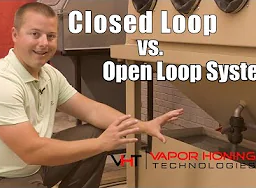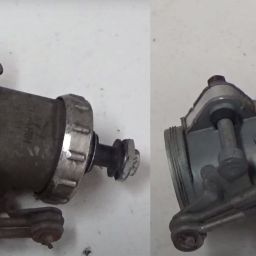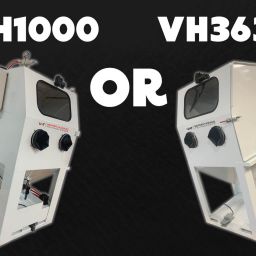What Abrasive Media Is Used in Vapor Blasting?
Vapor Blasting is a very versatile process if used correctly. The biggest question is what abrasive media is used in the vapor blasting process? The true answer to this is that most all abrasives have been used and can be used in the vapor blasting process.
The abrasive media in vapor blasting makes stripping old paint, rust, and other surface contaminates from your items quick and easy. This is the first step to any painting, restoration, or protective coating project.
Traditionally, you would have to clean and grind objects by hand to reveal the raw substrate. This required an immense amount of time, along with physical effort, solvents, cleaners, and sanders. Despite the time and effort required, there’s no guarantee you removed all the contaminants or the final surface will have an even texture.
Simply point and shoot the blasting nozzle at the object you’re blasting to efficiently remove all contaminants. But how do you pick the right abrasive media? Here’s everything you need to know about the available abrasive media used in vapor blasting.
A Recap on Vapor Blasting
Sand blasting is a process of propelling sand particles using compressed air onto a surface. The goal is to remove contaminants on the surface to leave it clean, textured, and raw. Blasting ensures a layer of paint or protective coating will adhere to and protect the material.
The problem with sand blasting is it requires multiple steps, such as cleaning the substrate to remove lodged sand particles. This method also creates dust pollution and doesn’t always offer the best surface finish.
Is there a better blasting method? Yes, the better process is vapor blasting.
Vapor blasting uses the same blasting media as dry blasting and often achieves a better finish. Vapor blasting uses water in the blasting process. The water prevents excess dust from forming and cushions the abrasive impact for a finer finish.
The water also allows for the recyclability of the abrasive media. This makes it both environmentally friendly and cost-effective.
Compared to dry blasting methods, vapor blasting is more versatile. It allows you to effectively blast a range of extremely tough materials. It also lets you blast the most sensitive and soft materials without damaging them.
How Vapor Blasting Works
You can wet blast objects of nearly any size, shape, and purpose both indoors and outdoors. Wet blast smaller engineering and automotive parts indoors in a vapor blasting cabinet. You can also clean concrete, outdoor walls, and larger machinery outdoors with abrasive blasters and halo nozzles.
There are a few different ways vapor blasting works depending on the type of vapor blasting equipment you’re using. All forms of vapor blasting methods use abrasive media and mix it with water.
Some equipment will add water to the dry abrasive media at the end of the blast nozzle. Water injection nozzles (WIN) and halo nozzles use this method.
WIN nozzles will dampen the abrasive media as it ejects from the nozzle. Halo nozzles introduce a blanket of water that surrounds the ejecting abrasive media. Both processes will suppress most (but not all) of the dust.
Vapor abrasive blasters and blast cabinets will mix the water into the abrasive media to create a slurry. Vapor abrasive blasters store the slurry in a hopper and then pump it into an airflow. The airflow propels the slurry onto the object you’re blasting.
A blast cabinet contains everything including the blasting object and slurry in an enclosed container. The cabinet will push the slurry through a compressor to blast it onto the object. A major benefit of blasting cabinets is you can recycle and reuse the abrasive media.
These latter two methods of vapor blasting result in less dust and water waste. You’ll have more control over the air pressure and level of texture.
Abrasive Media Properties
Almost every type of vapor blasting requires abrasive media. The abrasive media is the muscle that grinds down and removes contaminants on the surface of the object you’re blasting.
What some people find challenging is finding the right type of abrasive for their needs. There are many types of abrasive media designed for specific purposes.
You’ll find large, sharp, and durable abrasives ideal for stronger materials and alloys, like steel. Smaller, rounded, and softer materials, like plastic abrasives, are best for sensitive materials like soft metals and wood.
Here are the main properties to look for in abrasive media. These properties will determine the profile depth of the finished texture on the substrate.
Size
A rule of thumb is to choose the smallest particle needed for the job. Larger particles will leave greater indents and fewer impacts. Smaller particles will strip faster and offer better coverage to give you an even and uniform profile.
Abrasive media has a mesh sizing scale ranging from 6 to 1200 based on the number of mesh lines in a sieve per square inch. The lower the number, like 6, the more coarse. Most abrasive media will fall into the range of 20 and 170.
Shape
The abrasive media particles come in a range of irregular shapes. The shape will affect how deeply they cut into the contaminants and substrate you’re blasting. The shapes follow a classification based on how angular they are.
Some particles are angular and jagged. These will strip rust and old coatings the fastest. Therefore, the resulting finish will have a sharper profile.
Smooth and rounded particles are better for removing brittle coatings and mill scale. The resulting finish is more even with a finer profile.
The shape scale from most to least angular looks like this:
- Angular: crushed glass and coal slag
- Sub-Angular: garnet, plastic, and olivine
- Sub-Rounded: walnut and staurolite
- Rounded: glass bead
The materials and contaminants you’re blasting will help you determine the best abrasive shape to use in your blasting project.
Anchor Patterns and Surface Profiles
When abrasive media particles impact the surface of a substrate, they create little peaks and valleys. The valleys are the indentations in the substrate where the particle hits. The peaks are the areas of the substrate around the valley that push upwards upon impact.
The peaks and valleys will appear in the shape of the vapor blasting media. Angular abrasives will leave a deeper rougher profile while rounded particles will cause a dimpled profile, similar to the dimples on a golf ball.
Protective coatings have a specific surface profile depth you need to follow to ensure proper bonding. The profile is the surface roughness, also known as the anchor pattern. The coating will set and cover the peaks and valleys created during the blasting process.
Pay close attention to the recommended anchor patterns on your protective coatings. Surface profiles with too much depth will cause the peaks to poke through the coating, leading to premature rusting. A profile that’s too shallow will prevent the coating from adhering correctly and can lead to premature erosion.
The size, depth, and hardness of the abrasive media will have a direct effect on the anchor profile.
Density
The density of abrasive particles will give you insight as to how they will hit the object you’re blasting.
Particles with a greater density will have more kinetic energy upon impact over a smaller area. These particles will leave a deeper profile. Dense particles deform less and will absorb less kinetic energy during impact.
The specific gravity scale measures the density of abrasive media. The lower the number, the lower the density. Water has a specific gravity of one. Steel grit has a specific gravity ranging from 4.8 to 7.8 SG.
In vapor blasting, walnut, plastic, and plain water have the lowest density. The lower the density the more likely the abrasive will float rather than sink to the bottom of the hopper. Staurolite, garnet, and olivine have a greater density making them stronger and causing a deeper profile.
Hardness
While easily confused with density, the hardness of an abrasive particle refers to its strength rather than the kinetic force it can carry. A harder particle will leave a deeper profile.
The Mohs Hardness Scale measures how hard an abrasive particle is. The scale measures using a scale ranging from one to ten. One is the softest and ten is the hardest.
Most vapor blasting abrasive media fall between the numbers of two and nine. Sodium bicarbonate is the softest at two and a half while aluminum oxide has a rating of nine.
Softer abrasive media will leave a finer finish with a shallower profile. These are ideal for removing light paint coatings, grime, and grease. Choose a softer abrasive if you don’t want to risk leaving an anchor pattern on the substrate.
Harder abrasives are best for removing rust, corrosion, and thick layers of the old coating. These are a good choice for projects requiring a deeper profile and anchor pattern on the substrate.
Types of Abrasive Media for Vapor Blasting
There are many types and subtypes of abrasive media designed for specific blasting projects. The following list consists of the most popular abrasive media.
Before your pick a media to use on your next project, you should talk with one of our abrasive media professionals.
Silicone Carbide
Silicon carbide is an angular and fast blasting abrasive medial. It’s also one of the most aggressive abrasive particles available.
This blasting media a good choice for cutting materials or blasting very hard metal substrates. It has a hardness level of 9-9.5 Mohs, a very high etch profile, and recyclable.
Aluminum Oxide (Brown and White)
This abrasive media has a very angular and sharp shape. Aluminum oxide has a hardness of 8-9 Mohs making it an excellent choice for etching, profiling, and removing rust quickly. These particles come in a range of sizes from very coarse to very fine.
Its strength and durability make it long-lasting and recyclable.
Stainless Steel Grit and Stainless Steel Shot
Made from stainless steel, both of these abrasive materials have a hardness level of 8 Mohs and are highly recyclable.
Steel shot is spherical, offering a shallower surface profile. It’s great for cleaning, smoothing, and polishing hard surfaces. It has a little to no etch profile and comes in several sizes ranging from medium-coarse to ultra-fine.
Steel grit is an angular particle with sharp irregular edges. This is a better option for fast aggressive cleaning and stripping. It offers a high etch profile and ranges from coarse to medium sizes.
Garnet
This industrial gemstone is an angular and strong media great for cleaning and blasting hard substrate materials such as steel. The anchor pattern created by garnet is ideal for coating adhesion and grit transfer. It has a hardness of 7-8 Mohs, offers a high etch surface profile, and comes in varying sizes and coarseness.
Crushed Glass
Crushed glass is an angular and aggressive media good for removing coatings, surface profiling, and cleaning. It has a hardness of 5-6 Mohs and offers a medium-high etch profile in a short amount of time. This media isn’t recyclable or reusable.
Glass Beads
This lead and silica-free media are round, offering a bright smooth finish. The hardness is 5-6 Mohs and has a round shape that’s also highly recyclable. The etch profile is very low creating a satin finish.
Corn Cob
Corn cob is an organic particle safe for cleaning and stripping sensitive materials like wood. This angular abrasive media is 4.5-5 Mohs and has a variety of sizes ranging from coarse to fine. It creates no etch and is a slower abrasive for stripping surface prep.
Walnut Shell
This organic yet durable angular media is a great choice for projects requiring aggressive stripping without damaging the substrate. Walnut shell has a hardness of 4.5-5 Mohs and comes in sizes ranging from very coarse to extra fine.
Plastic Abrasives
With a hardness of 3-4 Mohs, this angular abrasive is a soft media ideal for surface preparation. It offers little to no etch profile on the substrate making it a great choice for those working with soft or sensitive materials.
Tips on Choosing the Right Abrasive Media
Choosing the right abrasive media will ensure the best anchor pattern for better adhesion of your protective coating. There will be little to no damage to your substrate and fewer chances of premature coating failure.
Do you have questions or want to discuss an upcoming project? Let us know! We’re happy to help you with any of your vapor blasting needs.








